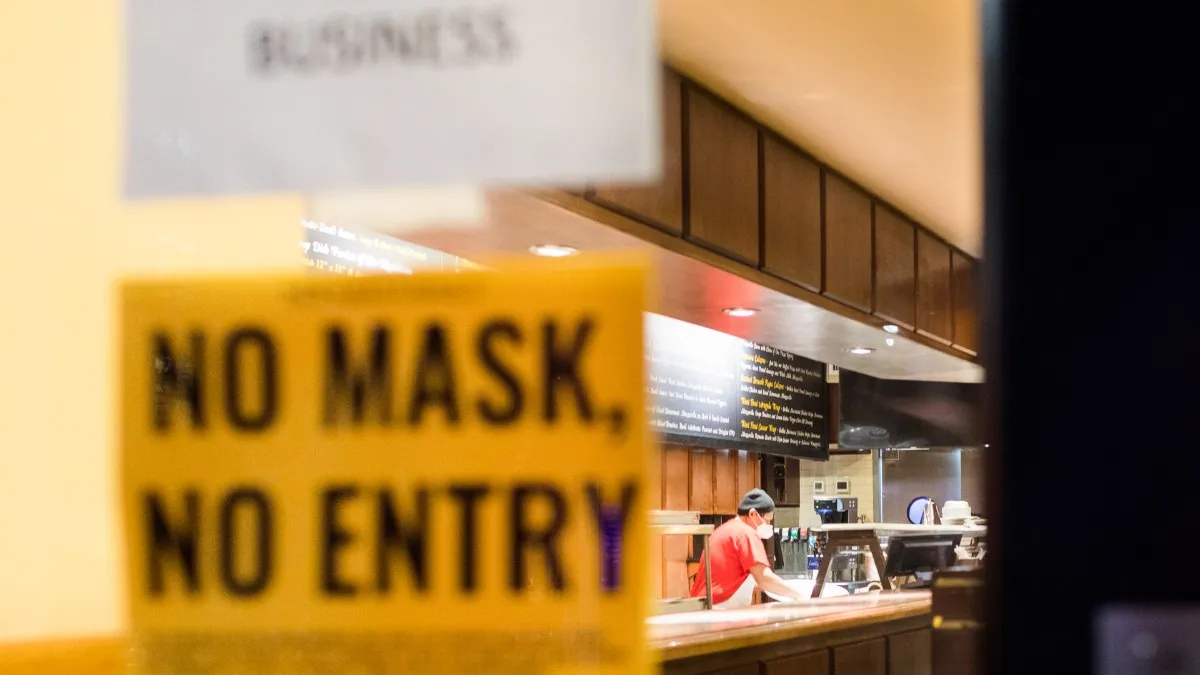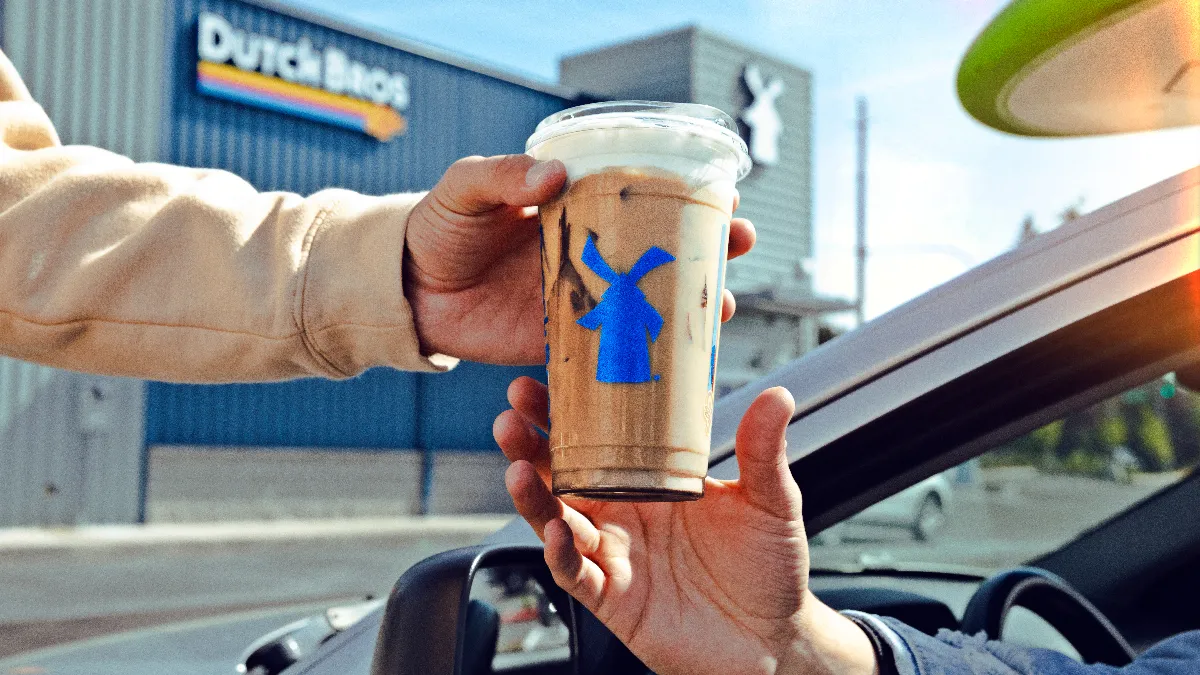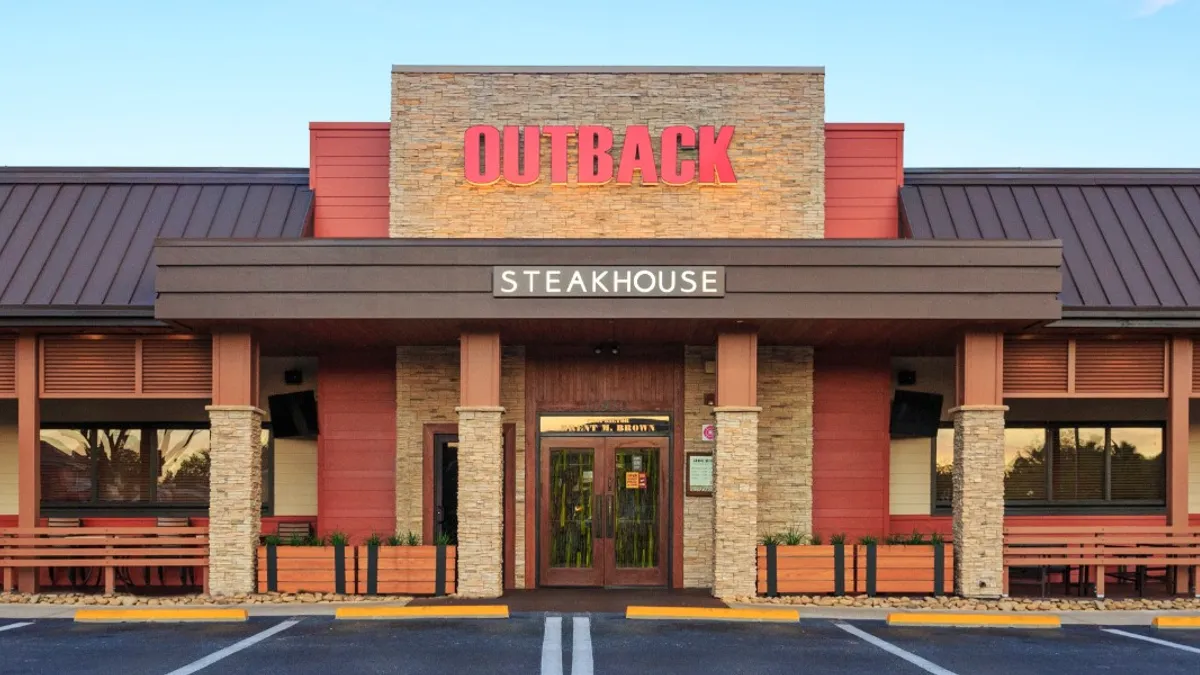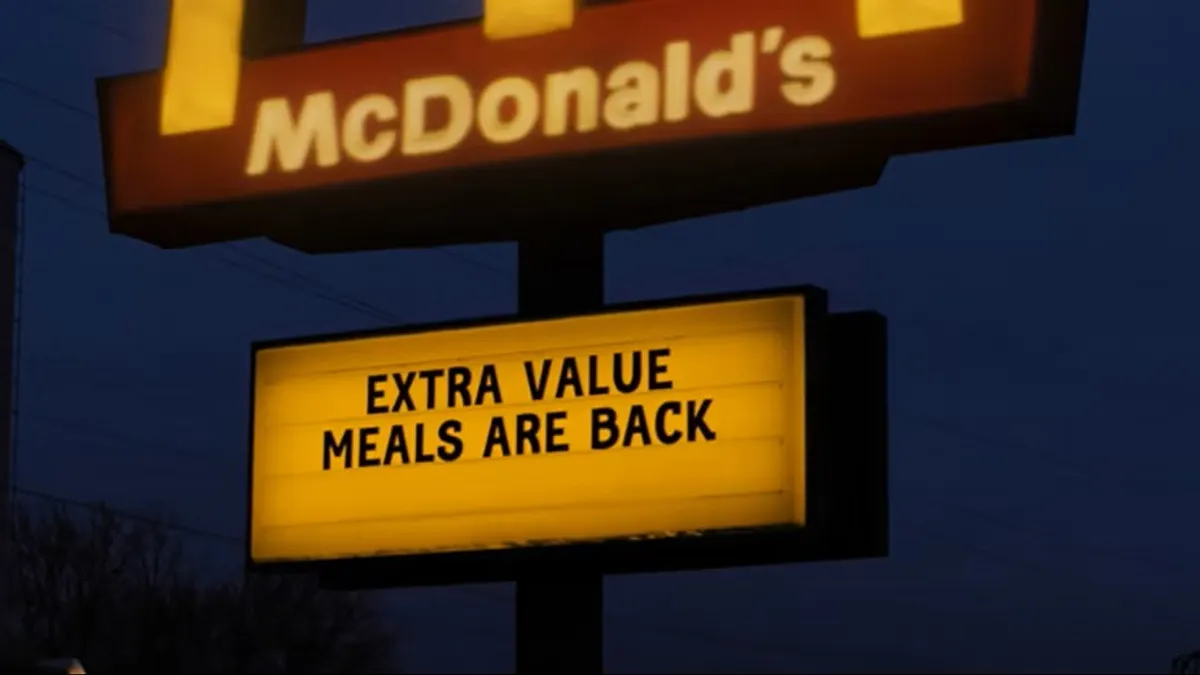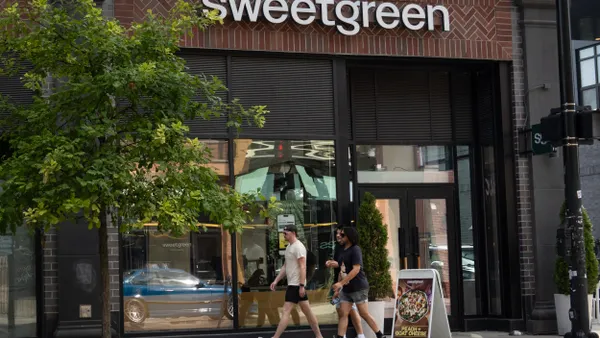This is the third article in a three-part series exploring strategies and techniques restaurants should consider before and after they reopen. The first in the series explored whether or not restaurants were ready to reopen amid social distancing restrictions and can be viewed here. The second looked into what restaurants should do before and after they bring their staff back and can be viewed here.
When customers are finally able to return to their favorite restaurants, dining rooms are going to look a lot different. Tables will be further apart, fewer people will be allowed in seating areas and servers and staff will likely wear masks and gloves as they take orders and pass trays.
It won’t be easy for restaurants to establish this new normal, given that the core of the industry is a people-to-people business.
“The customer piece of this is a really complicated area,” Alden Parker, co-chair of Fisher Phillips Hospitality Industry Group, told Restaurant Dive. “We don’t have a lot of guideposts at this point on how that’s going to work best … because there will be periods of time where people will have to interact at a distance closer than six feet to potentially take orders … that will naturally occur even with reduced capacity.”
Just like operators need to create a plan to bring back their employees, they should also develop strategies on how best to interact with customers while upholding social distancing standards. This could include requiring masks or checking temperatures as diners enter. Restaurants should also constantly communicate the efforts they’re taking to keep customers safe, experts told Restaurant Dive.
1. Plan around social distancing standards
Small retailers deemed essential, such as convenience stores, provide clues at how a business can function with social distancing measures, Bo Peabody, co-founder of online reservation platform Seated, which works with casual and fine dining restaurants, told Restaurant Dive.
“If a restaurant goes through the proper steps to ensure social distancing, they can make sitting at a restaurant no less safe than going to a liquor store or a convenience store,” Peabody said.
The National Restaurant Association recommends in its COVID-19 Reopening Guidance that restaurants should update floor plans in dining areas to make sure seating arrangements are at least six feet apart and to limit party sizes to no more than recommended by the CDC or what is approved by local or state governments.
Restaurants will likely have to bring out utensils in a paper bag and hand them to a customer instead of allowing them to use silverware that has been sitting at the table, David Bagley, managing director at Carl Marks Advisors, told Restaurant Dive. Carl Marks Advisors provides financial and operational services to companies in the middle market, including the restaurant sector.
“Little things like that just make the customer feel more comfortable,” Bagley said.
Technology like waitlist systems or even in-house text-based systems can help keep customers from congregating in a waiting area as well, Peabody said. If possible, a separate entrance and exit could be a good idea to eliminate people getting close in a door frame.
Strong traffic for pickup and delivery is unlikely to abate, so operators will also have to figure out how to properly separate diners coming in for takeout, Jim Collins, CEO of Kitchen United and founder, owner and operator of Town Kitchen and Grill in California, said during a Kitchen United webinar on April 23.
2. Set up for reduced capacity
In addition to following social distancing standards, states are also restricting the number of customers allowed inside at once. Texas, for example, mandates that dining rooms are capped at 25% of their original capacity, as does Alaska, which has the added caveat that only members of the same household can dine together. Georgia is allowing 10 patrons per 500 square feet while Tennessee is keeping dining rooms to 50% capacity.
While these limits may not impact operations as much in the middle of the week when traffic is typically down, it could be an issue during weekends, Bagley said. Most restaurants often do 60% to 70% of their business Thursday through Saturday nights, he said.
There is also a cost to reducing table capacity. A lot of restaurants have fixed tables or fixed booths that can’t be removed, Bagley said. And when the holidays come and capacity increases, an operator would have to put these tables and booths back.
Social distancing won’t be as difficult for restaurants in suburbs and rural areas where dining rooms tend to be a little more spacious. More compact urban restaurants, many of which often have 15 to 20 tables, would have to deal with significant drops in the number of customers allowed, impacting revenue, Bagley said.
“Those are the types of places that are really going to struggle. How do they overcome that? … By showing... that you care about the customers and their health by taking the steps, providing people with what looks like a standard sanitization program … that they can see and be aware of to feel comfortable,” Bagley said.
With social distancing and reduced capacity, restaurants will have to rethink their menus and how they use them, as well. The National Restaurant Association recommends cleaning and sanitizing menus or discarding paper menus after each use. Technology also could be used to reduce person-to-person interaction, such as using mobile ordering and menu tablets and providing contactless payment options, NRA said.
Instead of providing mixed cocktails, for example, bottled beer, wines or nonalcoholic drinks that can be poured into a cup could reduce exposure, Peabody said. Having a short menu or prix-fixe menu will be helpful for margins, since it can reduce dependence on a restaurant’s supply chain as well as decrease the amount of products and labor needed. Menus could also be written on a chalkboard as a replacement, Peabody said.
“From the guest perspective, it’ll just psychologically feel better to have to make fewer choices,” Peabody said. “And it’ll make payment easier.”
3. Understand the impacts to customer experience
While these social distancing strategies will help improve safety for employees and customers, they will also have a dramatic impact on the customer experience. Speed of service could worsen due to extra precautions being made in the back- and front-of-house, especially with fewer lines or POS positions open, Boyles said. Restaurants could also direct guests to pick up their food from the counter without having wait staff handle it, Peabody said, which would also impact the server-guest relationship.
“The face of your brand is the server, who works with your customers, knows your customers and remembers what they ordered last time,” Bagley said. “How is that going to be if the server is wearing a mask and having to wear gloves every time they come to your table? It just seems so foreign to us, and how do you work your way through that and kind of reinvigorate that connection with the customer.”
Social distancing standards will put additional burdens on the employer to make sure that a server isn’t interacting with a customer for over 10 minutes, per the CDC, especially since interactions between server and customer are likely to be less than six feet apart, Parker said.
“[This is] a business based on service of customers. That’s what ... restaurateurs love to do and that’s why they got into the business … because they love people,” Parker said. “Here there are barriers to being able to express that feeling toward other individuals. That’s just a real tough long-term impact on the industry.”
There are also concerns over what might happen if a customer does contract COVID-19 and traces it back to the restaurant even if all the standards are met. There could be a potential for lawsuits, similar to a slip and fall or some other injury sustained on the property, Parker said.
“We don't know from a liability standpoint, what those claims look like, or what they could conceivably be seeking, other than the generalized emotional distress of having COVID-19 and potentially some wage loss from that person,” Parker said. “It's very challenging to sort of crystal ball and see how you think that's going to all unfold.”
4. Communicate with customers about new safety procedures
Restaurants should also use social media as a way to stay in contact, remind customers about what they love about their brand and what operations will look like when they return.
Restaurants could provide behind-the-scenes looks at what work has been done to protect customers during their dining experience, according to Streetsense’s Restaurant + Bar Relaunch Tool Kit emailed to Restaurant Dive. For restaurants still planning their new dining rooms setups, they could also use customer polling to figure out what guests would be most comfortable with and use real-time feedback to make adjustments. Once a restaurant has a reopening date in mind, they can create “coming soon” messaging to let guests know the restaurant will be back in business.
A marketing strategy could include reminding customers of all the good times they’ve had at their favorite restaurant, such as birthdays, anniversaries and other special occasions.
“Re-creat[ing] that long-lost feeling is ... a marketing program that I think everyone is just waiting to roll out,” Bagley said.
But communication shouldn’t stop at the reopening. Customers will have high expectations for food safety practices, such as frequent sanitizing, glove use, restroom cleanliness and contactless hand sanitizers, Boyles said. Restaurants should include visual cues, such as signage or the presence of hand sanitizers or wipes for customers, and promotions on what the restaurant is doing front-of-house and back-of-house to keep employees and customers safe, Boyles said.
Restaurants should make sure they are sharing how they are complying with local regulations as well. Some cities and municipalities will have more strict standards, such as requiring servers to wear masks and gloves, while others may not, Collins said during the webinar. Different municipal regulations could cause confusion among diners who are expecting stricter standards and may think operators are creating an unsafe environment even when they are in compliance.
One way to avoid this is by printing out the webpage of city or county regulations and paste it to menus or in plain view to show that operations are in compliance, Collins said.
5. Understand new customer dining habits
While a marketing strategy will be key to getting customers back into the dining rooms, operators also need to understand how much dining habits have changed since before the pandemic.
“Customers may not come back at once for inside dining,” Boyles said. “They will want to see what others experience first. ... Due to the economic downturn, the customer base may change. People may scale down from fine dining to fast casual, etc. They may not go out to eat as often or purchase as much.”
Drive-thru, carryout, mobile ordering, curbside and delivery will likely make up a greater mix of sales compared to pre-COVID-19 days, and customers may try these options before returning to dining inside, Boyles said.
“It’s a tough time for America, but it’s a particularly difficult time for restaurants and other hospitality employers because the consumer mindset has changed a bit,” Parker said. “Their approach to dining out and dining in has changed, and we don’t know the long-term impact of this.”
Low gas prices could incentivize more people to start to travel and take vacations once restrictions are lifted, which could naturally increase dine-in sales, especially in the summer months, Parker said.
“We just don’t know … what the new normal is for this summer’s sales, and whether there’s going to be some sort of impact,” Parker said.
For more information on strategies and procedures for reopening, check out the National Restaurant Association’s COVID-19 Reopening Guidance and Streetsense’s Pandemic Relaunch Toolkit for Restaurants + Bars.



